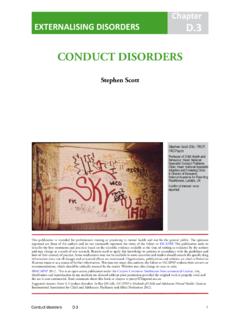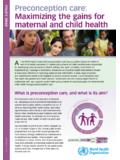Transcription of The importance of caregiver-child interactions for …
1 child AND adolescent HEALTH AND DEVELOPMENT . The importance of caregiver-child interactions for the survival and healthy development of young children A REVIEW. DEPARTMENT OF child . AND adolescent HEALTH. CAH. AND DEVELOPMENT. WORLD HEALTH ORGANIZATION. child AND adolescent HEALTH AND DEVELOPMENT . The importance of caregiver child interactions for the survival and healthy development of young children A REVIEW. DEPARTMENT OF child . AND adolescent HEALTH. AND DEVELOPMENT. CAH. WORLD HEALTH ORGANIZATION. WHO Library Cataloguing-in-Publication Data The importance of caregiver-child interactions for the survival and healthy development of young children: a review. development.
2 Psychology , Social in infancy and childhood factors , Linda Health Organization ISBN 92 4 159134 X (NLM classification: WS ). World Health Organization, 2004. This document is not a formal publication of the World Health Organization (WHO), and all rights are reserved by the Organization. With an identification of the WHO source, the document may, however, be freely reviewed, abstracted, reproduced and translated, in part or in whole, but not for sale nor for use in conjunction with commercial purposes. Permission to use a photograph must be obtained from the original source. The authors alone are responsible for the views expressed in this publication. Cover photo: WHO Department of child and adolescent Health and Development Designed by minimum graphics Printed in China Contents Photo credits iv Acknowledgements v Foreword vii Executive summary 1.
3 Chapter 1. Introduction: The role of caregiving in the development of children 5. Methodology for the review 5. The caregiver 6. Chapter 2. Historical background: The importance of stable, loving care for young children 8. WHO and the work of John Bowlby 8. The effects of separation from a familiar caregiver on the health and development of children 9. Chapter 3. Advances in child development theory and research: Perspectives from psychology, linguistics, neurobiology, and evolutionary theory 11. Contemporary psychological theories of how children develop 11. Psychoanalytic theory, particularly Object Relations Theory 12. Lev Vygotsky and social mediation 12. Developmental psycholinguistics 13.
4 Developmental psychology 14. Empirical findings regarding the perceptual and learning capacities of infants 16. Recent advances in understanding the neurobiology of early experience 18. Phylogenetic perspectives on human capacities for social and cultural communication and cooperation 19. Chapter 4. The nature of caregiver-child relationships: Attachment, development and cultural adaptation 22. Attachment theory 22. Developmental changes in caregiver-child relationships 25. Features of supportive and facilitative caregiver-child interactions 28. Mutuality, synchronicity, emotional availability, and social referencing 29. Sensitivity 30. Responsiveness 31. Applicability of caregiver-child dimensions across cultures 31.
5 Models of caregiving and parenting 33. iii THE importance OF CAREGIVER child interactions FOR THE SURVIVAL AND HEALTHY DEVELOPMENT OF YOUNG CHILDREN. Chapter 5. The impact of caregiver-child interactions on the development and health of children 36. child development outcomes 37. Follow-up studies from early interactions 37. Psychopathology and child abuse 38. Institutional care 39. child health outcomes 40. Prematurity and low birth weight 40. Growth and failure to thrive 41. Malnutrition 43. Chapter 6. Social and personal determinants of the quality of caregiver-child interactions 46. Socio-economic conditions 46. child characteristics 47. Caregiver characteristics 47.
6 Chapter 7. Improving caregiver-child interactions : Implications for intervention 51. Glossary 53. Bibliography 57. Photo credits Cover WHO Department of child and adolescent Health and Development Page 7 Linda Richter from the Birth to Twenty Study in Barbarin, O. A. & Richter, L. M. Mandela's Chil- dren: Growing Up in Post-Apartheid South Africa (2001). New York: Rutledge, p. 105. Page 11 Linda Richter Page 15 Lynne Murray and Peter Cooper in Murray, L. and Andrews, L. (2000). The Social Baby. Rich- mond, Surrey: The Children's Project, p. 53. Page 17 Meltzoff & Moore (1977). Imitation of facial and manual gestures by human neonates. Science, 198, 75-78. Page 18 Jacqueline Cid rac Page 20 Anthony De Casper Page 20 WHO Department of child and adolescent Health and Development Page 21 WHO Department of child and adolescent Health and Development Page 23 Linda Richter Page 29 Eleanor Gibson (Cornell University).
7 Page 30 UNICEF/HQ91-0173/Betty Press Page 32 WHO/S. Sprague Page 34 Linda Richter Page 38 Jane Lucas Page 41 WHO/Armando Waak Page 41 Jane Lucas Page 44 WHO/L. Taylor Page 48 Bob Daemmrich (The Image Works). Page 49 WHO/D. Whitney iv Acknowledgements T he author of this review was Dr Linda Richter, who is the Executive Director of child , Youth and Family Development at the Human Sciences Research Council and Professor, School of Psychology, University of Natal (South Africa). Dr Richter was assisted by Dr R. Dev Griesel, Research Professor in the School of Psychology at the University of Natal, and Ms Julie Manegold, an Intern at the Human Sciences Research Council.
8 Valuable comments and suggestions were provided by the following persons: Dr Kathy Bartlett (The Consultative Group on Early Childhood Care and Development and the Aga Khan Foundation, Geneva, Switzerland), Dr Maureen Black (University of Maryland, Baltimore, USA), Dr Meena Cabral de Mello (WHO Department of child and adolescent Health and Development, Geneva, Switzerland), Dr Patrice Engle (UNICEF New York, USA), Dr Ilgi Ertem (Ankara University Medical School, Ankara, Turkey), and Ms Zeynep T rmen (Intern, WHO Department of child and adolescent Health and Development). We gratefully acknowledge the contributions of Dr Jane Lucas (Nicosia, Cyprus), who reviewed and edited the document, and Dr Jose Martines (WHO Department of child and adolescent Health and Devel- opment), the project coordinator.
9 We thank Ms Sue Hobbs for the document's design and Ms Jacqueline Cid rac for her efforts to obtain permission to use the photographs in the document. The WHO Department of child and adolescent Health and Development supported this review as the second in a series to guide interventions to improve the health, growth and psychosocial development of children, particularly those living in resource-poor settings. The first in the series is A Critical Link: Inter- ventions for physical growth and psychological development (1999, WHO/CHS/ ), available in Eng- lish, French, and Russian. For these documents and further information, please contact: Department of child and adolescent Health and Development (CAH).
10 World Health Organization 20 Avenue Appia, 1211 Geneva 27, Switzerland Tel: +41 22 791 3281. Fax: +41 22 791 4853. E-mail: Website: v Foreword N early 11 million children died before reaching their fifth birthday in the past year. Almost 40% of these children die within the first It blends theory with current scientific evidence from both advantaged and resource-poor countries to describe the interactive processes that month of life. Millions of children survive but face shape this relationship during the first days diminished lives, unable to develop to their full through the early years of the child 's life. This potential. Poor nutrition and frequent bouts of relationship meets the child 's basic needs for food, illness limit the young child 's opportunities to safety, warmth, affection, and stimulation and explore the world during a critical period for the caregiver's need to feel effective and satisfied learning basic intellectual and social skills.
















